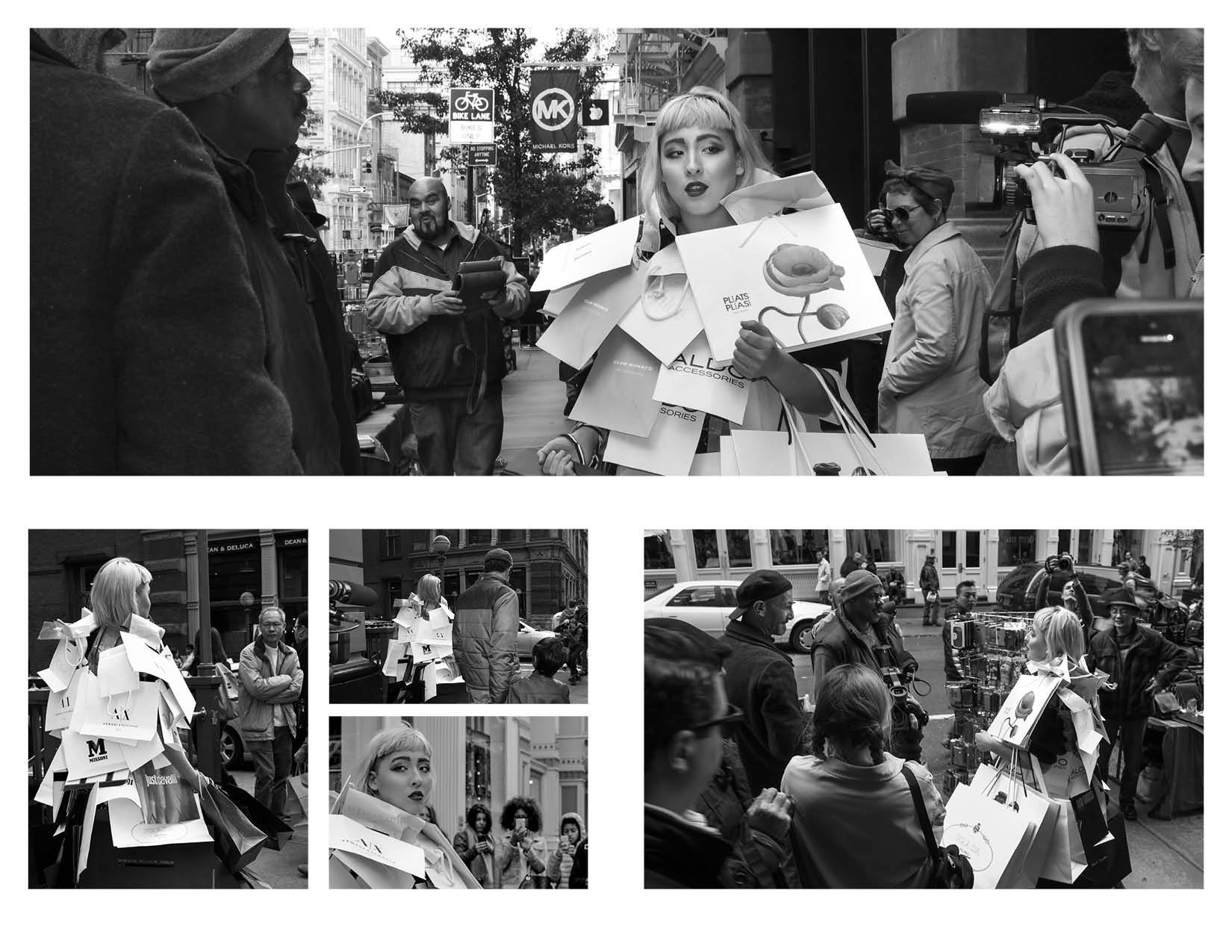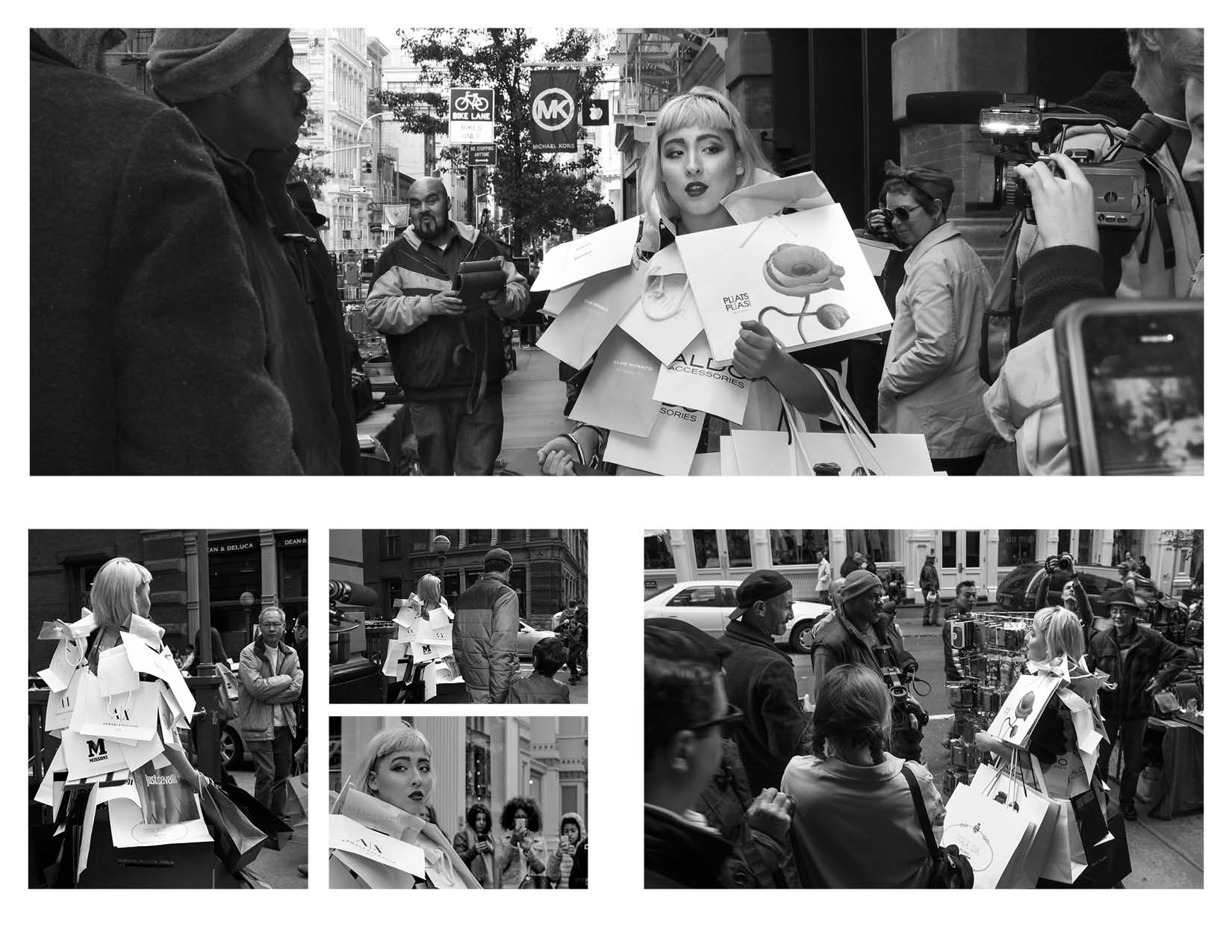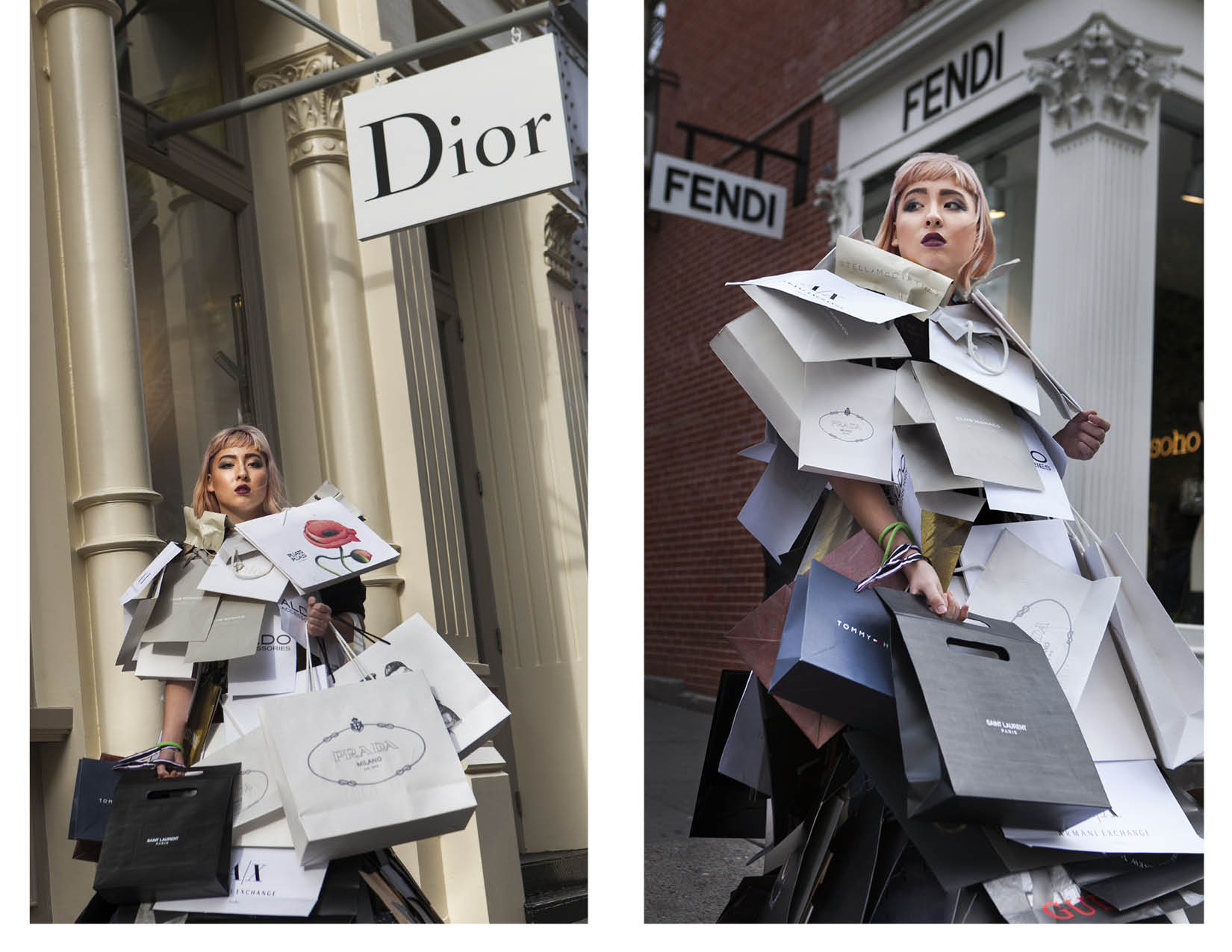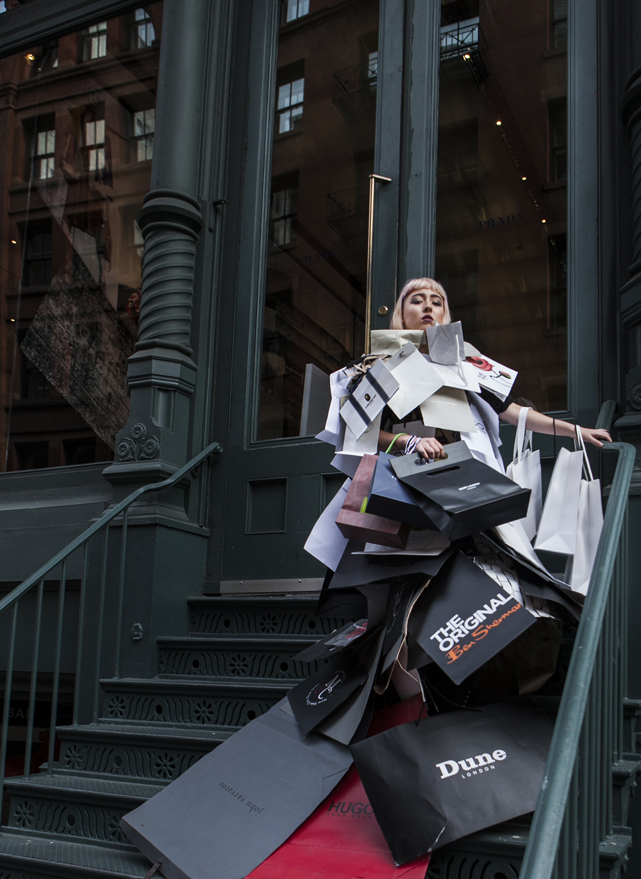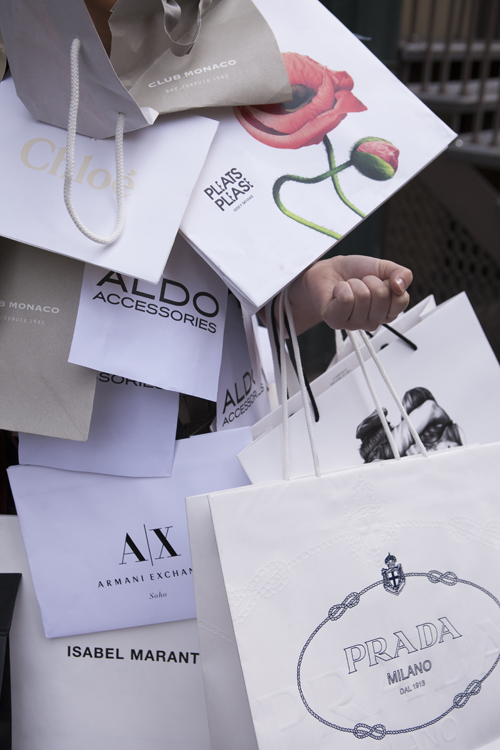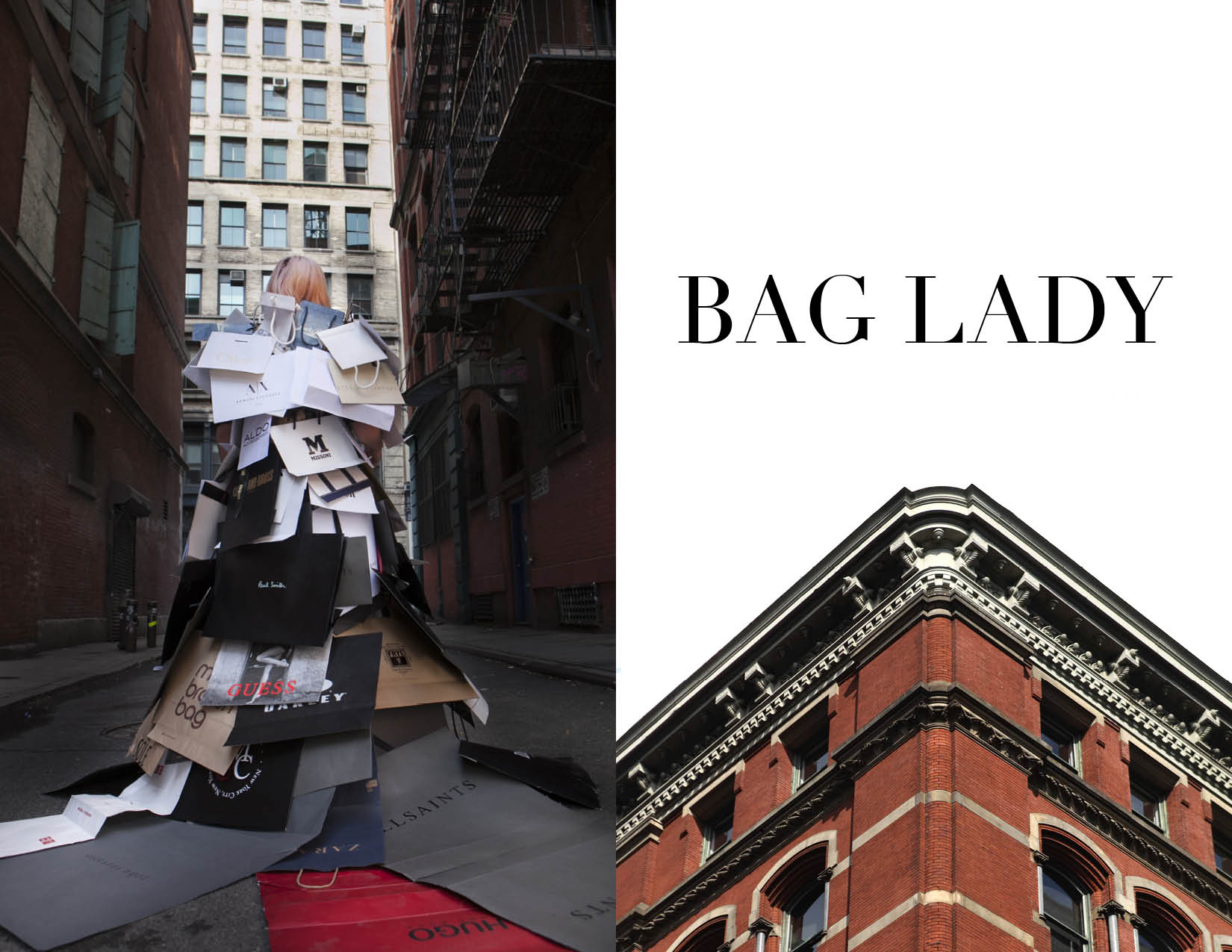Public Interaction: Isabel modeled the Soho dress for a fashion editorial photoshoot the group named “Bag Lady”. She caused quite a scene in the big, attention grabbing garment, both disrupting and intriguing the crowds of Saturday afternoon shoppers.
A couple weeks ago, I received an email from Cameron Durham at Parsons the New School for Design, telling me about a SoHo related project he completed with his Integrative Studio and Seminar class. The studio portion of the class is taught by Stacy Selier, exploring a range of visual, analytical and making skills while working on projects that draw upon collaboration and cross disciplinary investigation. The focus of this course is not only on the “how” of making things, but also the “why.” How is it that we make sense of our ideas, the information we collect, and our hunches and theories? And what can this inquiry tell us about why we make decisions as creative thinkers? The seminar portion of the class is taught by Andrea Marpillero-Colomina and explores the urban transformation and shift in New York City through analytical classroom discussions and writing projects.
Cameron told me that they used The SoHo Memory Project as a source of information when they were doing background research for their SoHo shift design. The finished “product” is quite interesting, melding history and fashion into a design for a shift. I would like to share it with you, as it presents a visual interpretation of SoHo from the point of view of designers who were all born after the transformation of SoHo from a community of artists to a retail hub—blank slates in a way, in that they never experienced SoHo as anything but the home of Kanye and Nine West.
Public Interaction: Isabel modeled the Soho dress for a fashion editorial photoshoot the group named “Bag Lady”. She caused quite a scene in the big, attention grabbing garment, both disrupting and intriguing the crowds of Saturday afternoon shoppers.
Shift as Camouflage: SoHo
By Diego Lawler, Tyler Truglio, Ginger Caranto, Isabel Conley, and Cameron Durham
SoHo (South of Houston), the historic district of “impeccable cast-iron industrial facades” is a relic of a prior era. Currently, one cannot walk down Broadway, observing the glamorous window displays of Prada, Chanel, and numerous less-exalted brands, without noticing the elegantly preserved structures of iron and brick. Having once been known as Hell’s Hundred Acres, SoHo could have easily been written off as a manufacturing hub inhabited by illegal artist residents and blue-collar society, but recently, gentrification has turned the area into a shopping mall for well-to-do suburbanites and visiting tourists. Drifting through the streets of New York City today, one would find that there is no other place that signifies the classic essence of effortlessly trendy and endlessly fashionable better than South of Houston. The first area in Manhattan to earn its own acronymic nickname, SoHo captures the perfect combination of past and present, compiled of sett paved roads and littered with brownstone buildings.
In our garment design for urban aposematism, we created an extravagant gown covered in shopping bags with designer labels. Taken from nearly every clothing store in SoHo, our dress showcased dozens of bags, which we layered on top of a chicken wire base. This garment design speaks to both the present and past aspects of the neighborhood. The shopping bags represent the consumerism, clothing store facades, and the gentrified culture of SoHo. As for the chicken wire base, that represents the historic cast-iron architecture. The combination of these elements signifies the now popular area, which is composed of upscale shopping and unique architecture.
Today, SoHo promotes the lifestyle of a chic and sophisticated present day New Yorker. However, SoHo was once an entirely different scene. In the mid-seventeenth, SoHo was the first free Black settlement on Manhattan Island, and before artists and aristocrats resided in the buildings, freed slaves of the Dutch West Indies Company were the primary inhabitants. During the American Revolution, SoHo’s Crosby Street was the site of army fortifications and redoubts. Sweatshops and factories paved the way for a new era, and these structures eliminated any trace of what used to be known as strictly a residential neighborhood.
The area was not seriously developed until after 1805, when the famously unsanitary Collect Pond was drained and filled to allow space for housing. Federal-style buildings from this era still stand on 68 and 70 Prince Street, and these buildings are noticeably shorter and less ornate. By 1850, the SoHo District developed into a residential community compiled of freestanding dwellings and small shops. In the 1850s, SoHo rapidly transformed into a commercial district of established labels such as, Lord & Taylor, Arnold Constable & Co., Tiffany & Co., and E.V. Haughwout. Broadway went from a street of brick retail shops to an avenue of marble, brownstone, and cast-iron commercial businesses. The 1850’s cast-iron buildings set the tone for SoHo’s architectural style, being an economical and fast solution to for the large-scale commercial buildings built at this time. Made in moulds then stuck to the face of buildings to spruce up pre-existing buildings, cast-iron elements were eventually integrated into new buildings. Another recognizable architectural element is the iconic Belgian blocks that pave most of SoHo’s street. These broad rectangular blocks resemble cobblestones but are larger and usually made of granite. Used for paving steeper streets, Belgian blocks provided horses’ hooves with better grip than a smooth surface.
As commercial development accelerated, a red light district appeared along the streets east and west of Broadway. Guidebooks to the area were published to steer clientele to the prostitution and gambling halls that populated the red brick Federal and Greek revival buildings that previously housed middle class families. In the late 1870’s, SoHo was transformed from the city’s entertainment area into the center for mercantile for dry good trade. Residential population moved out, making SoHo a ghost town at night. The area remained practically unchanged until the depression of the 1930s, when abandonments and foreclosures turned SoHo into a commercial slum full of unused storage spaces.
In the 1960’s, abstract artists became interested in the large unused commercial spaces in SoHo. The empty industrial spaces were perfect for artists yearning for large spaces to create their work. In 1966, a real estate co-op for artists named Fluxus was created, allowing artists to buy property for two dollars per square foot and a nominal charge of three cents per month. A restaurant commune named “Food” was founded and operated by seven artists who lived and worked in the SoHo area to provide inexpensive meals. A community of artists began to secretly establish themselves despite the area being zoned commercially and not residentially. Artists developed a system for living in SoHo “undercover” in the buildings. They did this by blacking out the windows; residents would leave the elevator on the first floor for late night guests, and tear up their mail to hide their address.
After 1971, artists could legally reside in the manufacturing buildings of SoHo after obtaining “Artist In Residence” (AIR) status. By the 1970s, art galleries started moving into SoHo. Four important Madison Avenue galleries moved into a renovated paper warehouse at 420 West Broadway. Leo Castelli, a famous art dealer, moved into the second floor of this warehouse. He represented many influential artists of the time, including Jasper Johns, Donald Judd, Dan Flavin, Andy Warhol, and Roy Lichtenstein. The large warehouse floors were perfect for the large-scale works of these artists.
Beginning in the 1970’s, SoHo became fashionable again. The threat of demolition of SoHo’s old buildings prompted the area’s Cast-Iron Historic District designation in 1973. In the early 80’s, boutiques, performance centers, galleries, restaurants, bars, and shops found their way into the cast-iron buildings of SoHo. The area, once a haven for avant-garde art, became an international marketplace for style and design. Today, the streets of SoHo are crowded with countless bright and modern store signs, but SoHo’s historic architecture remains. The neighborhood has withstood the tests of time by keeping a classic look, and although rapid changes in modern architecture would require a deconstruction of such outdated relics, SoHo’s distinguished cast-iron district was not torn down. Contrarily, the inhabitants of SoHo’s cast-iron remains are an ever changing breed of wealthy trendsetters and artistic pioneers.
The theme of aposematism and hidden development plays a role in the garment that we have designed. Our dress showcases present-day SoHo, which is contradictory of its history. We are representing the high-end culture of shopping that has suffocated Manhattan’s lower districts on the outside, whereas inside the dress, the structure of culture and history is well preserved. In a way, this is opposite to the historic buildings that encompass SoHo; the exterior of the old cast-iron buildings have not been altered, but the insides have taken on new purposes. Many of New York’s oldest buildings exist in SoHo, therefore, we wanted our dress to reflect the ever changing faces in the neighborhood, while at the same time referencing the alluring and long lasting architecture.
If SoHo’s style could be described in three words, they would be bohemian, eclectic, and chic. Based on our research we chose to make a garment to comment on the current culture in SoHo. We did this with a dress made of brand name shopping bags held together with a strong form. The form of the garment was made of chicken wire woven with recycled paper bags, which was then covered with shopping bags we collected from brand name stores in SoHo. The large skirt, train and chunky form of the dress create a large mass surrounding the model, partially covering the face, as if it is consuming the wearer. The large train spills off of the dress onto the sidewalk infecting the area surrounding the garment, forcing others to walk around it. Elements of sound are incorporated as the model walks, causing the bags to shift making a ruffled sound with each step. All of these elements make it difficult for the public to ignore especially in a crowded setting, creating a very confrontational garment. The shopping bags represent the attraction to brands, fashion and consumption that has taken a hold of SoHo culture. The invasive nature of the dress symbolizes a loss of individuality taken over by consumerism. The wearers lose themselves in the dress and becomes an advertisement for the brands which define a new identity. The glamorous 1960’s inspired style of the photography and classical lines in the form of the dress parallel the preserved historic architecture in SoHo, while capturing its current commercial face through the use of modern brands in the garment.
It is abundantly clear that SoHo’s style strongly reflects the culture of nouveau riche twentysomethings and hipsters who occupy the trendy area. Similar to many areas that have been gentrified, artists have been the modern pioneers of neighborhoods like SoHo. The initial artistic culture in the area has attracted a wealthier group of citizens over the years. Today, SoHo’s culture consists of tourists, celebrities and consumers who shop for brand name designs and search for fine dining in fancy cafes, restaurants and bars. SoHo currently exists as a hip, young, and stylish place to be. It is a wealth of cultures and customs with larger efforts of gentrification occurring every day. Gentrification creates a skyrocketing effect with apartment prices increasing by the minute. This causes the original artist inhabitants to flee to the outer boroughs and make way for a wealthier crowd to take their place. In one hundred years, it is hard to say what SoHo will look like, but one can only hope that it will be remembered as the heart of New York City’s artistic foundation.
Sources:
- http://www.nyc.gov/html/lpc/downloads/pdf/reports/SoHo_HD.pdf
- http://www.timeout.com/newyork/manhattan/soho-manhattan-neighborhood-guide
- http://www.nyc.gov/html/lpc/downloads/pdf/reports/sohoextdesignation.pdf
- http://ljacobs26.wordpress.com/2011/06/19/ethnography-part-1-soho-the-transformer/
- http://urbanomnibus.net/2013/06/living-lofts-the-evolution-of-the-cast-iron-district/

